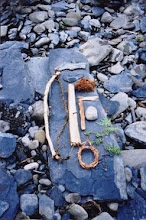
Recently Barry Keegan and I were talking as we were cutting the frame for our latest cabins here at Hawk Circle, about the nature of shelter. It was interesting, because we were talking about the longevity of shelters, how they have evolved through the ages and how it felt to be timber framing rather than peeling bark for a longhouse or wigwam or other native structure. Barry liked the idea of putting energy into the beams and frame, knowing that the cabin would likely live on past our own lives, to shelter campers and students well into the next generation if given proper care and maintenance.
On the other hand, a wigwam or longhouse has to undergo lots of repairs after about twelve to fifteen years, just due mostly to the constant contact with moisture and the nature of the bark, poles and lashings.
I made the point that it is much different building native shelters today, as compared to three hundred years ago, because then, you could find any number of huge elms, basswood and hickory trees, in a climax forest, and you could peel one or two trees and have all of the bark you could want, in huge sheets, ready to lash onto a sturdy frame. The Dutch Elm disease hadn't hit, and the forests hadn't been cleared by pioneers looking to farm the New World, as they liked to call it. Cherry Valley looked like Wales or Ireland only as far back as 70-90 years ago!
Now, it is hard work finding big elms for peeling, or basswood or tulip poplar, and we have to travel miles, peel it, transport it, store it carefully and then soak it for days to get it to form onto our shelters, often made at nature centers miles and miles from Hawk Circle. Much harder work!
Anyway, it was a good conversation, and it led to good thinking. Food for thought, as they say.
We are in the process of developing a Sustainability Apprenticeship, where adult students or homeschooled highschool age students could come and learn by doing, making timber framed cabins, learn about organic gardening, composting, caring for small livestock, gathering and processing foods, natural building like cob construction, cordwood masonry, straw bale construction, blacksmithing, tool care and use and much more. It is looking like it will be a practical approach to community living and sustainable methods, with a dose of cooking, baking, wild medicinals and even knitting thrown in for good measure.
I am really excited, because it could be a great way for students who want to take our Earth Skills Semesters to earn credit towards a course, and learn strong life skills too, and be part of our community. It looks like a win win, which I love!
Anyway, I will keep you posted and until then, I hope you are all enjoying the summer and getting outside and practicing your skills from time to time!
Ricardo













No comments:
Post a Comment